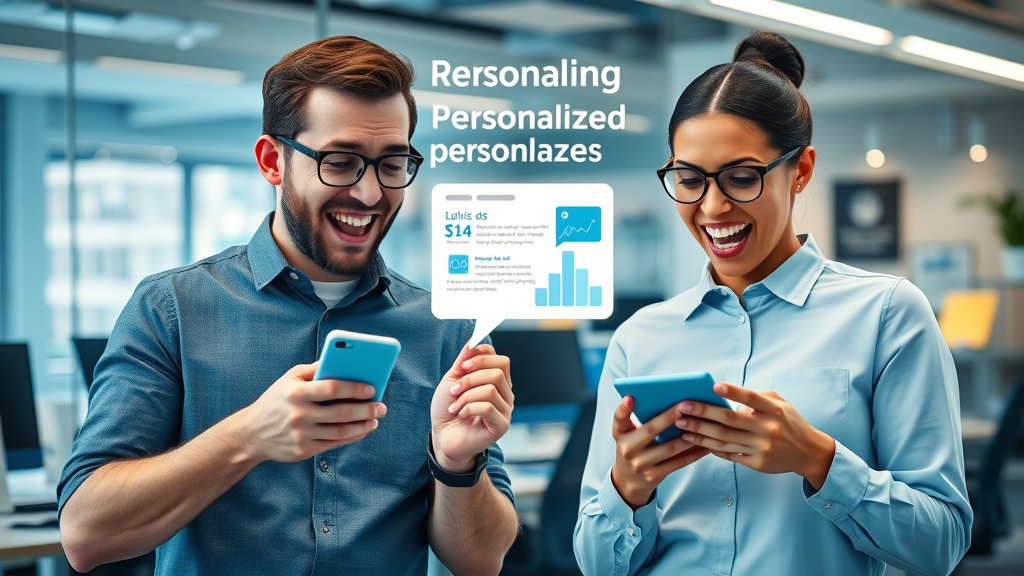Did you know that ads tailored to individual interests can increase engagement by up to 3x compared to generic campaigns? Personalized ads have rapidly become the secret weapon for brands aiming to connect instantly with modern audiences. In a world where attention spans are short and digital competition fierce, leveraging ad personalization isn’t just a luxury—it’s a necessity. Let’s dive into how personalized advertising supercharges results and how you can take advantage of this game-changing strategy right now.
Why Ad Personalization Matters: A Look at Surprising Consumer Trends
Consumers are bombarded with thousands of ads daily, making it harder for standard campaigns to break through the noise. Ad personalization dramatically shifts this landscape. A recent study found that effective ad personalization can lift engagement rates by over 200%, outpacing generic ads by a wide margin. This isn’t just a minor improvement—it’s a seismic change in how users interact with digital campaigns.
-
According to Epsilon research, 80% of consumers are more likely to engage with brands offering personalized experiences.
-
Personalized ad campaigns in social media and display networks have shown click-through rates grow by up to 300% versus non-targeted approaches.
-
Brands like Amazon and Netflix have famously driven conversions by leveraging advanced ad topics and behavioral targeting.

Take for example Spotify’s “Wrapped” campaign, which serves ads based on a user’s unique listening history. The result? Not only do users eagerly share their personalized insights, but Spotify also reports record-breaking engagement and subscription renewals. These examples prove that, when done right, personalized ads don’t just capture fleeting attention—they spark lasting loyalty.
Personalized Ads and Consumer Behavior: The Evidence
There’s a growing body of evidence underlining the power of ad personalization on user behavior. Recent industry stats show:
-
Personalized ads improve user retention rates by up to 50% compared to generic advertising.
-
Brand satisfaction scores are 3x higher among users who regularly see relevant ads based on their personal information and browsing habits.
-
Surveys confirm that 75% of consumers are more likely to make repeat purchases after engaging with tailored digital advertising.
This data-driven approach to advertising not only encourages immediate clicks but also paves the way for long-term relationships, increased lifetime value, and positive word of mouth.
What You'll Gain from Mastering Ad Personalization
By embracing ad personalization , you unlock several advantages:
-
Actionable ad tactics: Instantly deploy advanced targeting using ad center tools and google account settings.
-
ROI insights: Learn practical methods to measure and optimize your personalized advertising efforts for maximum return.
-
Consumer trust: Build transparency and user confidence through clear privacy controls and ethical data use.
-
Immediate engagement: Experience higher click-through rates, user satisfaction, and greater conversions from the start.
By following this guide, you'll gain actionable steps to personalize ads across major platforms, ensuring your brand is not just seen, but remembered.
Understanding Ad Personalization: Foundations and Key Concepts
What is Ad Personalization and How Does It Work?
Ad personalization refers to the strategy of tailoring advertisements to individual user preferences, demographics, and behaviors. Rather than serving identical ads to every visitor on a site or app, advertisers utilize personal information —like browsing history, account activity, and Google Search data—to determine which ad topics and formats are most likely to resonate. This means the ads you see on social media, Google services, or your mobile device are dynamically chosen based on your prior digital interactions, creating experiences that feel more relevant and less intrusive.
-
Google account data, such as age, gender, and interests, is routinely used to serve ads closely aligned to each user’s profile.
-
Sites and apps leverage cookies and device identifiers to track activity, continuously refining the accuracy of targeted ads.
-
Email addresses and search history inform Google Ad and display network campaigns, enabling advertisers to show you personalized ads at the perfect moment.
The Building Blocks of Personalized Ads Across Google Services
Within Google services and the wider online advertising ecosystem, several core elements enable personalized advertising to flourish:

-
The ad center serves as the command hub, allowing users and advertisers to manage ad settings, select topics, and review personal data used for targeting.
-
Advertising ID—a unique identifier on your mobile device —enables apps and websites to link activity to a non-personal profile, powering relevant ads without direct personal identification.
-
Google services (YouTube, Gmail, Google Search) and their interconnected apps use combined data streams to deliver consistent, high-performing personalized ads on every touchpoint.
This multi-faceted approach ensures that ads from Google and third-party brands are always evolving to reflect your current interests and digital journey.
Getting Started: Setting Up Ad Personalization in Major Ad Centers
Navigating the Ad Center: Your Hub for Ad Personalization
Activating and managing ad personalization often starts with the ad center—an intuitive interface found in most advertising platforms (including Google and Facebook). Here’s how you take control:
-
Log in to your main advertising platform and locate the ad center or advertising dashboard.
-
Select “Ad Settings” to review current personalization status, then activate or deactivate specific ad topics, interests, and categories.
-
Tune ad delivery via filters for age, location, device, and even time of day, ensuring ads reach the right audience at the optimal moment.

Many platforms offer analytics and reports right within the ad center, so you can immediately track the performance of your newly personalized ads and continue refining your approach based on real user feedback.
Personalizing Ads on Google Account and Google Services
To reap the full rewards of personalized ads through Google account management, simply follow these steps:
-
Head to the “Ad Settings” page in your Google account dashboard.
-
Review which personal information (age, gender, interests, web and app activity) is being used to show you personalized ads.
-
Adjust ad topics, update profile data, or enable/disable personalized advertising with just a few clicks.
This seamless integration across Google Search , YouTube, and Gmail ensures relevant ads are delivered no matter which Google service you’re using—all under your direct control.
How Sites and Apps Use Personal Information for Ad Personalization
Sites and apps play a pivotal role in ad personalization by collecting and protecting your data:
-
Data is gathered from activities like browsing, purchases, and app usage. This includes location, device type, and behavioral patterns.
-
This information is then processed—often anonymously or using advertising ID—to inform which ad topics and formats should be delivered to each unique user.
-
Sites and apps are increasingly operating under strict privacy regulations (such as GDPR and CCPA), ensuring that the collection and use of personal information for advertising is both transparent and optional.
As a result, users benefit from more relevant ads while retaining significant control over their privacy and online experience.
Optimizing Ad Topics, Ad Formats, and Delivery
Selecting the Right Ad Topics for Maximum Personalization
Choosing the correct ad topics is crucial for creating truly effective personalized advertising . Advanced targeting allows advertisers to:
-
Map ad topics directly to user demographics (age, location), interests (sports, technology, fashion), and online behaviors (search queries, shopping activity).
-
Develop segmented campaigns in the ad center, pairing high-value ad topics with the audiences most likely to convert.
-
Leverage real-time data from Google services and advertising platforms to keep your strategy current and hyper-relevant.
This method ensures every ad serves a specific purpose—making customers feel seen and understood, not just targeted.
Experimenting with Different Ad Formats in Personalized Advertising

-
Display Ads: Great for brand awareness. Static or animated visuals tailored with user data for maximum resonance.
-
Video Ads: Leverage robust personalization by recommending content, products, or special offers based on previous views and interests.
-
Native Ads: Seamlessly blend with app or website content, using subtle cues from user profiles to enhance relevance while minimizing disruption.
Testing multiple ad formats and tracking which converts best within your audience segment is the surest route to optimized ROI—and ensures your personalized ad campaigns never feel static or stale.
Privacy, Transparency, and User Control in Ad Personalization
Understanding Ad Center and Advertising ID: Protecting User Privacy
User privacy sits at the core of modern ad personalization discussions. The ad center offers:
-
Centralized access to all ad preferences, allowing users to tweak ad topics, turn off personalized ads, or opt out of data usage entirely.
-
The advertising ID on your mobile device gives apps the power to serve ads based on your interests—without ever handing over direct personal information.
By harnessing anonymized identifiers and transparent controls, platforms strike a balance between relevant advertising and personal privacy—a win-win for brands and users alike.
Empowering Users to Turn Off Personalized Ads
Not every user wants or feels comfortable with personalized ads. Fortunately, the process to turn off personalized ads is straightforward:
-
Open your primary ad center (e.g., Google, Facebook), navigate to “Ad Settings,” and select the option to “Turn Off Personalized Ads.”
-
Alternatively, adjust core settings within your Google account or via your mobile device’s settings menu under privacy or advertising categories.
-
Once disabled, you’ll return to receiving contextual ads based on general browsing, rather than those tailored to your specific profile.

This control fosters trust and aligns with evolving privacy-first digital landscapes.
Transparency in Personalized Ads: Building Consumer Trust
“Consumers are savvy—they expect brands to use personal data responsibly for tailored experiences.” – Industry Leader
Ethical collection and use of personal information have become the gold standard for ad personalization success. Brands and advertisers gain credibility by:
-
Clearly disclosing which data is collected and how it powers relevant ads.
-
Offering transparent, user-friendly tools to review, edit, or delete ad profiles.
-
Never using sensitive or private data for advertising without full user consent.
When users feel in control, their appreciation for personalized ads only increases—laying the foundation for long-term loyalty.
People Also Ask About Ad Personalization
Can you turn off ad personalization?
Yes, you can turn off ad personalization via the ad center or your Google account settings. Disabling this feature means you’ll only see contextual—rather than tailored—ads, minimizing the use of your personal information. This shift helps protect privacy while ensuring ads remain relevant on a general level.
What does ad personalization do?
Ad personalization uses your browsing, app activity, and Google services data to display ads that match your interests and preferences. This strategy increases engagement by ensuring you encounter offers and content that reflect your actual needs and habits, making digital advertising more helpful and less disruptive.
Is personalization good or bad?
Personalization offers clear benefits—like seeing more relevant ads and enjoying a smoother online experience—but it can also raise concerns about privacy. Deciding if ad personalization is good or bad depends on your comfort with data sharing and whether you value convenience over anonymity. Most platforms now let you tailor these controls to your liking.
How do I turn off ad settings?
You can manage ad settings either in your Google account or directly through the ad center on most advertising platforms. Options include turning off personalized ads, refining unique ad topics, or limiting access to your personal information, allowing for granular control over your digital advertising experience.
Step-by-Step Guide to Personalizing Ads Using Google Services
-
Log into your Google account.
-
Navigate to your ad center from the account dashboard or settings.
-
Review and update your personal information (interests, activity) used for ad personalization.
-
Select ad topics and formats that match your preferences for more relevant ads.
-
Test and monitor personalized ad campaigns using analytics provided within Google services and the ad center dashboard.
Measuring the ROI of Ad Personalization Campaigns
|
Metric |
Generic Campaigns |
Personalized Ad Campaigns |
|---|---|---|
|
Engagement Rate |
1.2% |
3.8% |
|
Conversion Rate |
0.6% |
2.4% |
|
Ad Spend Efficiency |
$0.20 per click |
$0.07 per click |

-
For best results, track KPIs like click-through rate, conversion rate, and bounce rate across all advertising platforms.
-
Analyze split-testing data to determine which ad formats , topics, and targeting strategies yield the highest ROI.
-
Leverage multi-platform analytics (Google Analytics, Facebook Insights) to consolidate learnings and optimize spend in real-time.
Troubleshooting Common Issues with Ad Personalization
-
Seeing irrelevant personalized ads: Update your ad topics and personal info in the ad center or Google account. You may also clear site or app activity logs for a fresh start.
-
Difficulty turning off personalized ads: Go to your ad center’s settings, ensure you’re logged into the right account, and look for “Turn off personalized ads.” If trouble persists, visit platform-specific help centers for direct support.
-
Personal information errors impacting ad topics: Double-check that your Google account and connected apps have correct age, location, and interests. Outdated or inconsistent info can negatively impact targeting accuracy.
-
For ongoing issues, consult the official support sections of your advertising platforms. They often have troubleshooting guides, community forums, and personalized assistance for deeper problems.
Expert Insights on the Future of Personalized Ads
“The evolution of ad personalization hinges on AI and enhanced privacy protocols—balancing innovation with user trust.” – Digital Advertising Expert
-
AI-powered targeting: As artificial intelligence advances, expect even sharper, more individualized recommendations—while streamlining the creative process.
-
Regulatory shifts: Regulations like GDPR and state-level privacy laws are reshaping data collection, demanding greater transparency and user control in all aspects of personalized advertising .
-
Privacy-first technologies: Differential privacy, encrypted data, and user-centric consent portals will soon become standard, reinforcing consumer trust while still delivering relevant ads.
Staying ahead of these trends ensures your ad personalization strategies remain both effective and compliant in a rapidly shifting digital world.
Frequently Asked Questions About Ad Personalization
-
What sources contribute to ad personalization?
Data comes from Google account activities, sites and apps you use, device identifiers, and sometimes email addresses or social media profiles. -
Can I personalize ads on apps outside of Google services?
Yes! Most modern advertising platforms let you personalize ads based on in-app behavior, device settings, and linked social profiles. -
How is my advertising id used?
Your advertising ID anonymously links your device activity to non-personal ad profiles, helping advertisers deliver relevant ads without direct access to your private details. -
What happens when I turn off personalized advertising?
Disabling personalization means ads will no longer be tailored to your interests. You’ll see more generic campaigns, which may be less relevant but use less personal information for targeting.
Top Tips to Maximize Results from Your Ad Personalization Strategy
-
Continuously test different ad formats , ad topics, and segmented audiences to pinpoint the best performers.
-
Be transparent about what data is used in personalized ads and give users simple controls to customize or turn off ad personalization as needed.
-
Monitor evolving standards from the ad center and privacy regulators, adapting quickly to changing compliance and best practices.
-
Actively solicit user feedback to fine-tune campaign messaging, creative, and targeting approaches for ongoing improvement.
Summing Up: Why Now Is the Time to Embrace Ad Personalization for Instant Engagement
-
Embracing ad personalization now delivers measurable lifts in engagement, boosts brand loyalty, and optimizes ad spend—when balanced with responsible privacy practices and innovation.
-
Act quickly to refine your personalized advertising strategy, ensuring your brand stands out and thrives in today’s evolving digital ecosystem.
-
-
This explainer video shows how personalized ads connect with users, featuring real-life success stories and at-a-glance tips to get started.
-
-
Follow this hands-on tutorial as it guides you through the ad center setup and effective adjustments in Google account ad settings.
-
-
Unlock advanced strategies for automating and managing large-scale personalized ad campaigns, as explained by industry pros.
To enhance your understanding of ad personalization, consider exploring the following resources:
-
Learn More about Video and Gaining Traction with Prospects? Obtain Your Copy of the “Integrated Video Marketing Strategy for Small Businesses” by Clicking the Link
-
“Ad Personalization: Definition, Examples & Best Practices” ( celtra.com )
This article provides a comprehensive overview of ad personalization, detailing various strategies such as demographic, behavioral, contextual, and predictive personalization. It also discusses the importance of data collection and processing, especially in light of evolving privacy regulations.
-
“All About Ad Personalization” ( mailchimp.com )
This resource delves into different ad personalization strategies, including demographic, behavioral, contextual, predictive, and retargeting approaches. It offers practical steps for implementing these strategies, such as data collection, audience segmentation, and crafting tailored ads for specific customer segments.
By reviewing these resources, you’ll gain deeper insights into effective ad personalization techniques and best practices, enabling you to create more engaging and relevant advertising campaigns.
 Add Row
Add Row  Add
Add 




Write A Comment